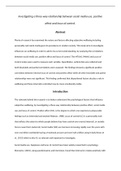Investigating a three-way relationship between social media use, positive
affect and locus of control.
Abstract
Plenty of research has examined the nature and factors affecting subjective wellbeing including
personality and social media given its prevalence in modern society. This study aims to investigate
influences on wellbeing in order to add to its current understanding, by analysing the correlations
between social media use, positive affect and locus of control. The MTUAS, PANAS and Locus of
Control scales were used to measure each variable. Quantitative, ordinal data was collected and
both bivariable and partial correlations were assessed. The findings showed a significant positive
correlation between internal locus of control and positive affect while all other bivariable and partial
relationships were not significant. This finding confirmed that dispositional factors do play a role in
wellbeing and those internally controlled may be more emotionally stable.
Introduction
The rationale behind this research is to better understand the psychological factors that influence
subjective wellbeing, by investigating a three-way relationship between positive affect, social media
use and locus of control. Positive affect (PA), is the degree to which one experiences pleasurable
feelings such as interested and excited (Watson, 1988). Locus of control (LC) is a personality trait
that reflects the extent to which people believe they have control over events (internal), or outside
forces cause them (external). Social media (SM) use has been increasing rapidly over the years with
over one billion worldwide having a Facebook account and over half a billion using it daily (Kross et
al., 2013) which is why it’s so relevant and important to investigate.
Social media use, happiness and locus of control have been widely researched in psychology.
Klonowicz, (2001), using questionnaires and interviews, found that internal LC relates positively with
,PA while external LC correlates negatively. Research into SM use and wellbeing has been
inconclusive, for example Kross et al., (2013) showed Facebook use predicts reduction in subjective
wellbeing and Huang’s, (2010) meta-analysis showed that high Internet use was related to reduced
well-being. However, others report the opposite such as Valenzuela, Park, and Kee, (2009) showed
positive links with social trust and life satisfaction indicating increased social capital from Facebook
use. Lodyga (2009) found that those high in external locus of control are more focused on their body
image hence use social media to compare themselves in turn negatively affecting their wellbeing
compared to those who are internally controlled.
This study used General Social Media Usage subscale from a new Media and Technology Usage and
Attitudes Scale (MTUAS; Rosen et al., 2013). This is an appropriate measure because it incorporates
a range of modern technologies. All 15 subscales showed strong internal reliability and high validity
when compared to data from established measures such as a sleep study. The Positive and Negative
Affect Scale (PANAS; Watson et al., 1988) was used to measure positive affect because the validation
shows it is representative of emotional states and convergent validity against measures of similar
constructs such as depression. The Locus of Control Scale (Rotter, 1966) was used to measure
internal locus only and it is an effective scale because of its discriminant validity due to low
correlations such as with intelligence.
This study used a correlational design which was an appropriate method because it allows us to
study our variables naturally as they occur in people because it would be impractical and unethical
to manipulate them. It allows for a statistical and quantitative analysis of data to investigate the non-
causal relations between our covariates. The method involved measuring participants’ PA, SM use
and LC using the described scales and analysing the scores for bivariable and partial correlations. The
results would indicate the direction (either positive or negative) and strength of a correlation shown
by the “r” value.
, The key question of interest is how, if at all, the covariables of PA, LC and SM use correlate in three
two- way relationships and one three-way relationship? Based on the literature review discussed
above, the study predicts that high internal LC will positively correlate with PA and will negatively
correlate with SM use. SM use will correlate with PA either positively or negatively due to the mixed
results of previous research.
Method
Participants
In total, 484 participants took part in the study with 208 males, 273 females and 3 preferred not to
say, ranging from 18-60 years old (Mean= 20.94, SD= 7.80). The sample contained students from the
university of Warwick as well as family, friends and others all over 18 years old, excluding psychology
students. They were all recruited in person using an opportunity sampling. Participants were asked
to part-take in the study if they were willing and able to, without being given any financial or other
incentives.
Design
This study used correlational design hence each participant provided scores for all 3 measures: SM
use, PA and LC. Bivariable and partial relationships between the following co-variables were
investigated: SM use as a predictor and PA as outcome variable, LC (predictor) and SM use, LC
(predictor) and PA. In the partial correlation analysis, the study looked at how locus of control affects
the relationship between SM use and PA.
Measures
The General Social Media Usage subscale was used to measure SM use (MTUAS; Rosen et al., 2013).
The subscale contains 9 questions and uses a 10-point frequency scale from 1 (“Never”) to 10 (“All




